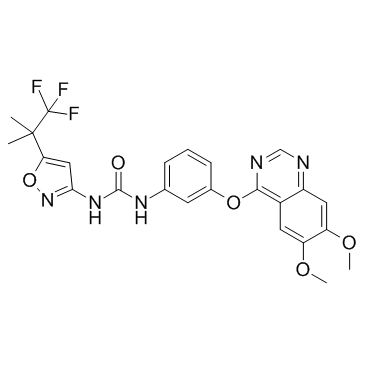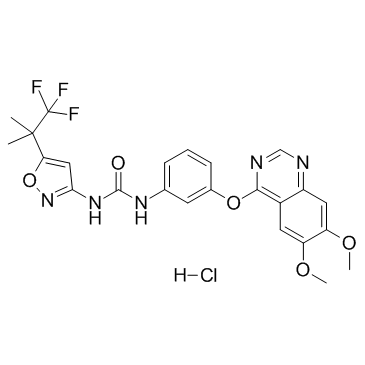1188910-76-0
| Name | 1-[3-(6,7-dimethoxyquinazolin-4-yl)oxyphenyl]-3-[5-(1,1,1-trifluoro-2-methylpropan-2-yl)-1,2-oxazol-3-yl]urea |
|---|---|
| Synonyms | CEP-32496 |
| Description | CEP-32496 is a highly potent and orally efficacious inhibitor of BRAFV600E with a Kd of 14 nM. |
|---|---|
| Related Catalog | |
| Target |
BRafV600E:14 nM (Kd) Braf:36 nM (Kd) CRAF:39 nM (Kd) c-Kit:2 nM (Kd) Ret:2 nM (Kd) LCK:2 nM (Kd) Abl-1:3 nM (Kd) VEGFR-2:8 nM (Kd) CSF-1R:9 nM (Kd) EPHA2:14 nM (Kd) EGFR:22 nM (Kd) c-Met:513 nM (Kd) JAK-2:4700 nM (Kd) MEK-1:7100 nM (Kd) MEK-2:8300 nM (Kd) |
| In Vitro | CEP-32496 exhibits high potency against several BRAFV600E-dependent cell lines and selective cytotoxicity for tumor cell lines expressing mutant BRAFV600E versus those containing wild-type BRAF. CEP-32496 exhibits potent binding (BRAFV600E Kd=14 nM) and cellular activity (pMEK IC50=82 nM and A375 proliferation IC50=78 nM), with activity in the proliferation assay. CEP-32496 also exhibits a favorable CYP450 inhibition profile, with measured IC50 values greater than 10 μM versus the CYP1A2, CYP2C9, CYP2D6, and CYP3A4 isoforms and an IC50=3.4 μM versus CYP2C19[1]. |
| In Vivo | Oral administration of CEP-32496 to Colo-205 tumor xenograft-bearing mice results in significant inhibition of pMEK in tumor cell lysates. For instance, a single 30 mg/kg (po) dose of CEP-32496 leads to a 50 and 75% inhibition of normalized pMEK in tumor lysates at the 2 and 6 h postdose time point, respectively (p<0.03), while a 55 mg/kg (po) dose resulted in a 75% to 57% (p<0.03) inhibition of pMEK at 2 through 10 h post administration, with normalization to baseline by 24 h. CEP-32496 exhibits an exceptional PK profile in mouse, dog, and cynomolgus monkey. Administration of CEP-32496 to beagle dogs (single dose of 1 mg/kg iv and 10 mg/kg po) results in low clearance (CL=5.0 (mL/min)/kg) and excellent bioavailability (%F=100). Similarly, in cynomolgus monkey, the administration of CEP-32496 (single dose of 1 mg/kg iv and 10 mg/kg po) leads to high oral exposure due to low clearance (CL=6.7 mL/min/kg) and excellent bioavailability (%F=100)[1]. |
| Kinase Assay | KINOMEscan competition binding assays are performed. Kinases are produced displayed on T7 phage or by expression in HEK-293 cells and tagged with DNA. Binding reactions are performed at rt for 1 h, and the fraction of kinase not bound to test compound (e.g., CEP-32496) is determined by capture with an immobilized affinity ligand and quantitation by quantitative PCR. Each kinase is tested individually against each compound. Kd values are determined using eleven serial 3-fold dilutions and presented as mean values from experiments performed in duplicate. Variability between individual values is less than 2-fold[1]. |
| Cell Assay | A375 cells are seeded at 10,000 cells per well in DMEM with 10% fetal calf serum and allowed to attach. The cells are washed with PBS and switched to DMEM with 0.5% of serum and incubated overnight. The test compounds (e.g., CEP-32496; 10 μM) are then added at various concentrations with a final DMSO concentration of 0.5% and incubated for 72 h. At the end of incubation, a Cell Titer Blue is added per instructions, and incubation is continued for 3 h. Remaining viable cells are quantified by measuring the strength of the fluorescence signal using SoftMax Pro (excitation at 560 nm and emission at 590 nm). IC50 values are derived using a 9-point curve and are presented as mean values from experiments performed in duplicate[1]. |
| Animal Admin | Mice[1] Six to eight week old athymic nu/nu nude mice (20-25 g) are inoculated subcutaneously with Colo-205 tumor cells (1×106/mouse) in the right flank. Upon reaching an average tumor volume of 150-200 mm3 (10-12 days post implantation), animals are randomized into treatment groups (n=10 mice/group). Each group is dosed orally for 14 days with either vehicle only (22% HPβCD) or with CEP-32496 at 10, 30, or 100 mg/kg twice daily (BID), and each dose of drug is given in a volume of 0.1 mL per 20 g of body weight, adjusted for the body weight of the animal. Tumor volumes are measured three times weekly using vernier calipers, and volumes are calculated[1]. |
| References |
| Molecular Formula | C24H22F3N5O5 |
|---|---|
| Molecular Weight | 517.45700 |
| Exact Mass | 517.15700 |
| PSA | 127.35000 |
| LogP | 5.34670 |
| Storage condition | -20℃ |
| Precursor 0 | |
|---|---|
| DownStream 1 | |

